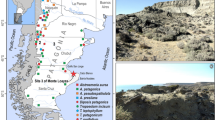Abstract
Early pottery sherds excavated in northern China date back to more than 11,000 cal a BP, and are presumed to have been used as cooking vessels. There has been, however, no direct evidence to demonstrate this function. Here we report ancient starch grains recovered from carbonized residues adhering to the bases of flat-bottomed vessels excavated from the Zhuannian site dating more than 10,000 cal a BP in the North China Plain. This evidence demonstrates that early pottery was being used to cook cereal grains, particularly millets, and acorns. Because millets were in the process of domestication at this time, we propose that pottery invention in northern China may have been related to early farming activities.



Similar content being viewed by others
References
Zhushchikhovskaya I (1997) Current data on Late Pleistocene/Early Holocene ceramics of the Russian Far East. Curr Res Pleistocene 14:89–91
Keally C, Taniguchi Y, Kuzmin Y et al (2007) Chronology of the beginning of pottery manufacture in East Asia. Radiocarbon 46:345–351
Boaretto E, Wu X, Yuan J et al (2009) Radiocarbon dating of charcoal and bone collagen associated with early pottery at Yuchanyan Cave, Hunan Province, China. Proc Natl Acad Sci USA 106:9595–9600
Wu X, Zhang C, Goldberg P et al (2012) Early pottery at 20,000 years ago in Xianrendong Cave, China. Science 336:1696–1700
Zhu Y (1999) The origin of pottery in China and other related issues. In: Xu Z, Zhang Z (eds) A trans-century rethink on Chinese archaeology. Commercial Press, Hong Kong, pp 91–111 (in Chinese)
Yan W (2000) The origins of rice agriculture, pottery and cities. In: Yan W, Yasuda Y (eds) The origins of rice agriculture, pottery and cities. Cultural Relics Publishing House Press, Beijing, pp 3–7 (in Chinese)
Wang T (2007) The discovery and research on the early pottery outside of China. Cult Relic Cent Chin 2:50–58 (in Chinese)
Rice P (1999) On the origins of pottery (ceramic technology among complex hunter-gatherers). J Archaeol Method Theory 6:1–54
Craig O, Saul H, Lucquin A et al (2013) Earliest evidence for the use of pottery. Nature 496:351–354
Yuan J (2002) The origin of rice and pottery in Yuchanyan, Dao County, Hunan Province. In: Yasuda Y (ed) The origins of pottery and agriculture. Roli Books, New Delhi, pp 157–166
Prendergast M, Yuan J, Bar-Yosef O (2009) Resource intensification in the Late Upper Paleolithic: a view from southern China. J Archaeol Sci 36:1027–1037
Craig O, Chapman J, Heron C et al (2005) Did the first farmers of central and eastern Europe produce dairy foods? Antiquity 79:882–894
Craig O, Steele V, Fischer A et al (2011) Ancient lipids reveal continuity in culinary practices across the transition to agriculture in Northern Europe. Proc Natl Acad Sci USA 108:17910–17915
Evershed R (2008) Organic residue analysis in archaeology: the archaeological biomarker revolution. Archaeometry 50:895–924
Isaksson S (2009) Vessels of change: A long-term perspective on prehistoric pottery-use in southern and eastern middle Sweden based on lipid residue analyses. Curr Swed Archaeol 17:131–149
Zarrillo S, Pearsall D, Raymond J et al (2008) Directly dated starch residues document early formative maize (Zea mays L.) in tropical Ecuador. Proc Natl Acad Sci USA 105:5006–5011
Yang X, Jiang L (2010) Starch grain analysis reveals ancient diet at Kuahuqiao site, Zhejiang Province. Chin Sci Bull 55:1150–1156
Yu J (2002) Features of early Neolithic culture in North China Plain as seen at the Zhuannian site. Beijing Cult Relic Archaeol 5:37–43 (in Chinese)
Therin M, Fullagar R, Torrence R (1999) Starch in sediments: a new approach to the study of subsistence and land use in Papua New Guinea. In: Gosdon C, Hathor GJ (eds) The prehistory of food: appetites for change. Routledge, London, pp 438–462
Yang X, Wan Z, Perry L et al (2012) Early millet use in northern China. Proc Natl Acad Sci USA 109:3726–3730
Yang X, Kong Z, Liu C et al (2009) Characteristics of starch grains from main nuts in North China. Quat Sci 29:153–158 (in Chinese)
Yang X, Zhang J, Perry L et al (2012) From the modern to the archaeological: starch grains from millets and their wild relatives in China. J Archaeol Sci 39:247–254
Yang X, Barton HJ, Wan Z et al (2013) Sago-type palms were an important plant food prior to rice in Southern Subtropical China. PLoS One 8:63148
Yang X, Perry L (2013) Identification of Ancient Starch Grains from the Tribe Triticeae in the North China Plain. J Archaeol Sci 40:3170–3177
Liu L, Field J, Fullagar R et al (2010) A functional analysis of grinding stones from an early Holocene site at Donghulin, North China. J Archaeol Sci 37:2630–2639
Zohary D, Hopf M (2000) Domestication of plants in the Old World, 3rd edn. Oxford Science Publications, Oxford
School of Archaeology and Museology of Peking University, Centre for Archaeological Study of Peking University, Beijing Institute of Cultural Relics, 2006. Early Neolithic Donghulin site in Mentougou District of Beijing. Archaeology 7:3–8 (in Chinese)
Zhao Z (2014) The process of origin of agriculture in China: archaeological evidence from flotation results. Quat Sci 34:73–84 (in Chinese)
Acknowledgments
This work was supported by the Strategic Priority Research Program of the Chinese Academy of Sciences (XDA05130603 and XDA05130402), and the National Natural Science Foundation of China (40771205 and 41371217).
Conflict of interest
The authors declare that they have no conflict of interest.
Author information
Authors and Affiliations
Corresponding author
About this article
Cite this article
Yang, X., Ma, Z., Wang, T. et al. Starch grain evidence reveals early pottery function cooking plant foods in North China. Chin. Sci. Bull. 59, 4352–4358 (2014). https://doi.org/10.1007/s11434-014-0500-6
Received:
Accepted:
Published:
Issue Date:
DOI: https://doi.org/10.1007/s11434-014-0500-6




